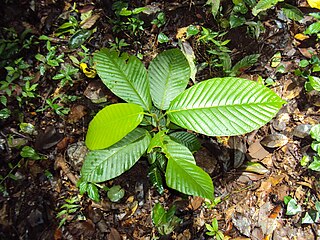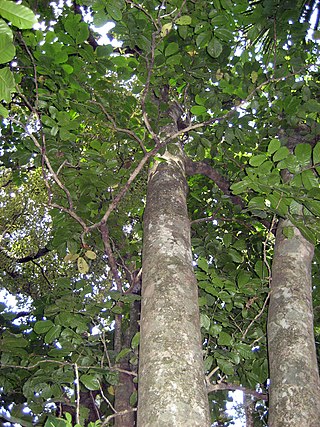
Canarium is a genus of about 120 species of tropical and subtropical trees, in the family Burseraceae. They grow naturally across tropical Africa, south and southeast Asia, Indochina, Malesia, Australia and western Pacific Islands; including from southern Nigeria east to Madagascar, Mauritius, Sri Lanka and India; from Burma, Malaysia and Thailand through the Malay Peninsula and Vietnam to south China, Taiwan and the Philippines; through Borneo, Indonesia, Timor and New Guinea, through to the Solomon Islands, Vanuatu, New Caledonia, Fiji, Samoa, Tonga and Palau.

Dipterocarpus is a genus of flowering plants and the type genus of family Dipterocarpaceae.

Dysoxylum is a genus of rainforest trees and shrubs in the flowering plant family Meliaceae. About 34 species are recognised in the genus, distributed from India and southern China, through southeast Asia to New Guinea, Solomon Islands, and Australia. The name Dysoxylum derives from the Greek word ‘Dys’ meaning "bad" referring to "ill-smelling" and ‘Xylon’ meaning "wood".
Pseudocarapa is a genus of flowering plants in the family Meliaceae. It includes five species which range from Sri Lanka to Sumatra, Peninsular Malaysia, Borneo, and New Guinea.

Dipodium, commonly known as hyacinth orchids, is a genus of about forty species of orchids native to tropical, subtropical and temperate regions of south-east Asia, New Guinea, the Pacific Islands and Australia. It includes both terrestrial and climbing species, some with leaves and some leafless, but all with large, often colourful flowers on tall flowering stems. It is the only genus of its alliance, Dipodium.

Didymocheton is a genus of flowering plants in the family Meliaceae. It includes 41 species which range from eastern India through Indochina and southern China to Malesia, Papuasia, eastern Australia, New Zealand, and the South Pacific.
Prasoxylon is a genus of flowering plants in the family Meliaceae. It includes seven species which range from Nepal and eastern India through Indochina to southern China, Taiwan, Malesia, Sri Lanka, Papuasia, and Queensland.

Didymocheton muelleri, the red bean or Miva mahogany, is a rainforest tree in the family Meliaceae. It occurs in tropical, sub-tropical and littoral rainforests in eastern Australia, from the Bellinger River in New South Wales in the south, to the wet tropics of north-eastern Queensland. A signposted red bean tree may be seen near the car park of Victoria Park Nature Reserve in north-eastern New South Wales.

Cratoxylum sumatranum is a species of flowering plant in the Hypericaceae family. It is indigenous to Southeast Asia, including Burma, Indochina, Thailand, Malaysia, Sumatra, Java, Lesser Sunda Islands, Borneo, Philippines and Sulawesi.

Pterophylla fraxinea, formerly known as Weinmannia fraxinea, is a tree in the family Cunoniaceae. It grows up to 40 metres (130 ft) tall. The bark is grey to dark brown. Inflorescences bear up to three pairs of flowers. The specific epithet fraxinea is from the Latin meaning "ash tree", referring to the leaves' resemblance to those of the genus Fraxinus.

Chisocheton is a genus of trees in the family Meliaceae. The genus name comes from the Greek schizos and chiton meaning "split tunic", referring to the lobed staminal tube of C. patens. Their range is from India and tropical China, throughout Malesia and south to New South Wales and Vanuatu.
Epicharis cuneata is a tree in the family Meliaceae.
Dysoxylum magnificum is a tree in the family Meliaceae. The specific epithet magnificum is from the Latin meaning "magnificent".
Prasoxylon rigidum is a tree in the family Meliaceae. The specific epithet rigidum is from the Latin meaning "rigid", likely referring to the leaflets.
Didymocheton mollissimus is a species of tree in the family Meliaceae. It ranges from eastern India and Bangladesh to southern China, Myanmar, Thailand, Peninsular Malaysia, Borneo, Sumatra, Java, the Lesser Sunda Islands, and the Philippines, where it grows in lowland tropical moist forests.

Epicharis parasitica, commonly known as yellow mahogany, is a species of rainforest tree in the family Meliaceae native to Taiwan, parts of Malesia, Papuasia, and northeast Queensland.

Didymocheton gaudichaudianus, commonly known as ivory mahogany, is a species of rainforest tree in the family Meliaceae, native to Malesia, Papuasia, Queensland, and some southwest Pacific islands.

Rhododendron javanicum is a rhododendron species native to Indonesia, Malaysia, and the Philippines. This evergreen shrub grows to 5 m (16 ft) with bright orange flowers in spring. Plants may be terrestrial or epiphytic. Some forms from the Philippines may have red or bicoloured flowers, but are less often seen in cultivation.
Epicharis is a genus of flowering plants in the family Meliaceae. It includes seven species which range from Indochina to south-central China, Taiwan, Malesia, Papuasia, Queensland, and Fiji.
Didymocheton mollis is a species of flowering plant in the family Meliaceae. It is a tree native to Sulawesi, the Maluku Islands, New Guinea, and the Bismarck Archipelago.











